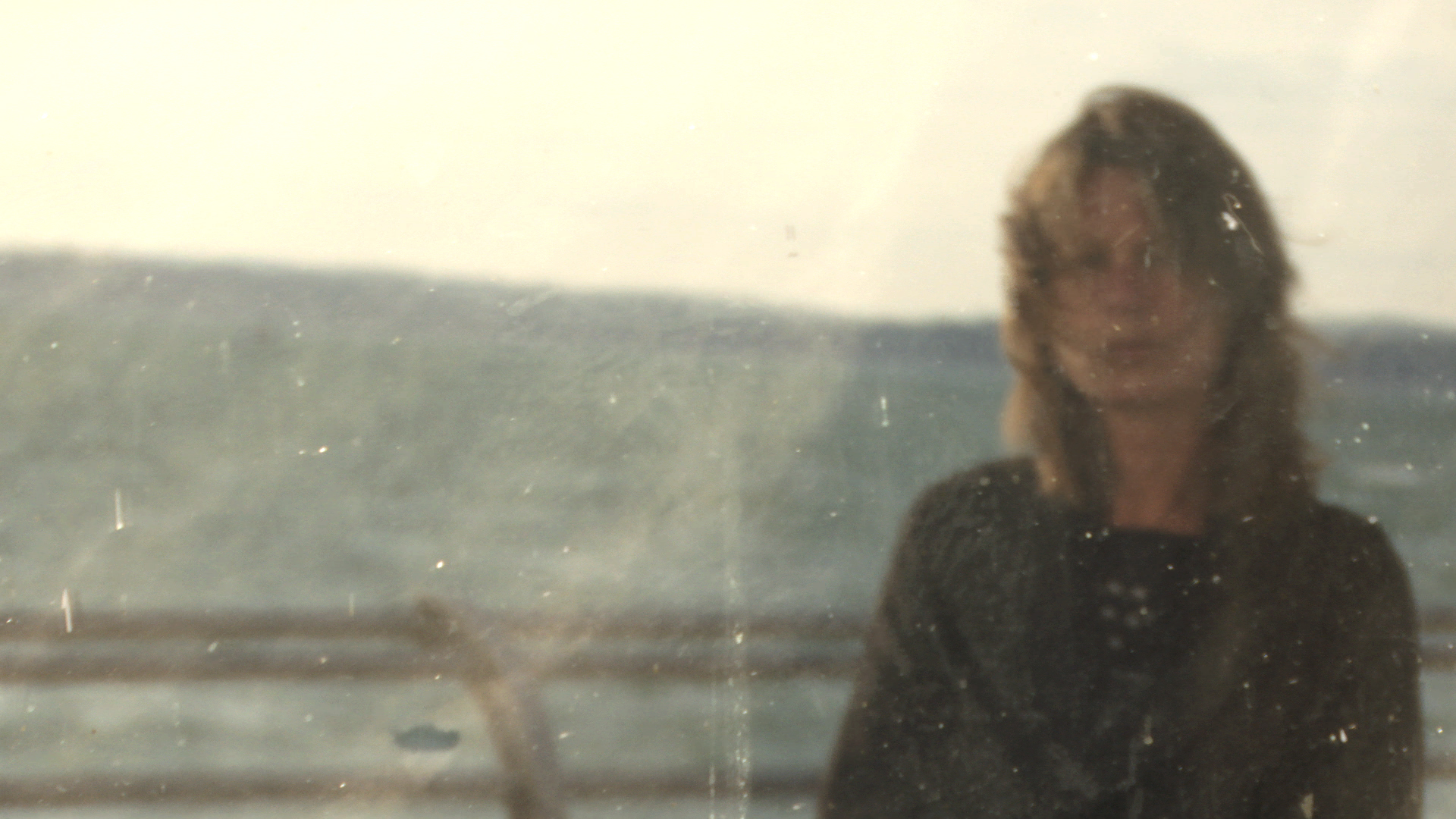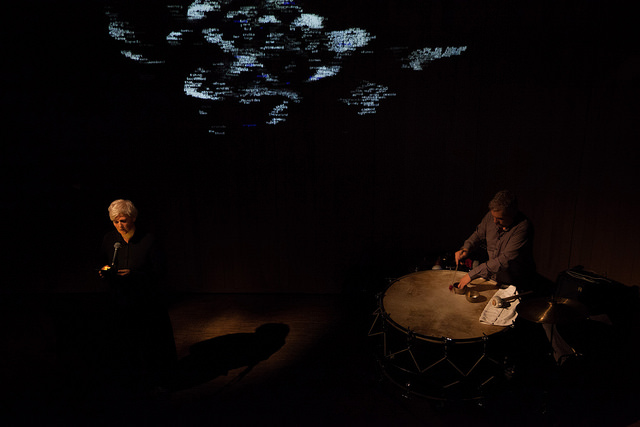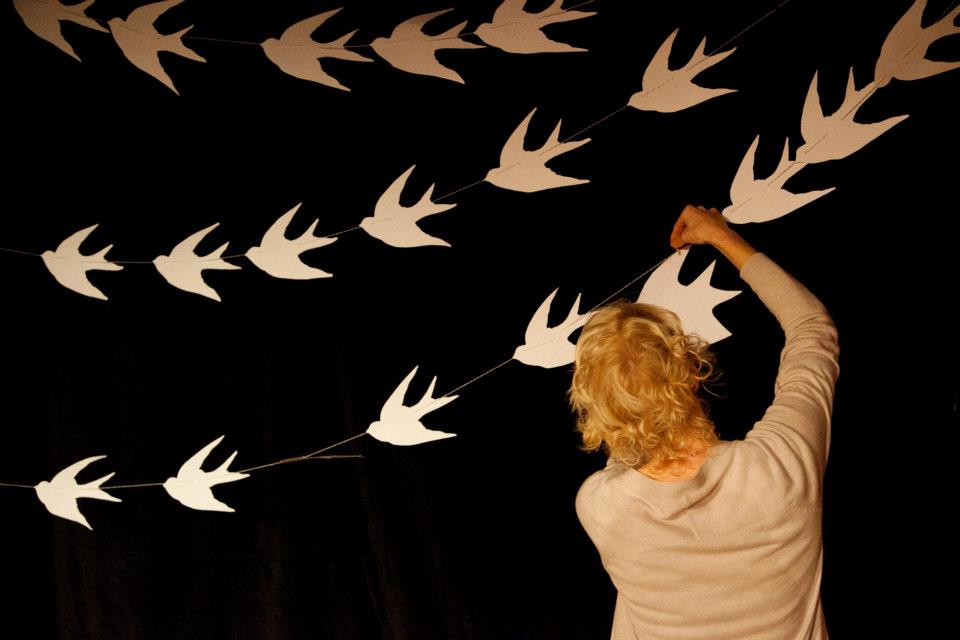A recent trend in UK poetry is what I might call ‘multimedia projects’ or ‘live literature,’ a development that interests me for several reasons.
Like many poets, I have a love-hate relationship with poetry readings. As an audience member, I find that some readings can feel electric or even transcendent. But others can be dull, wearisome or worse.
And as a poet who gives readings, I sometimes wonder, ‘Is performing really my best skill?’ I’m not trained as an actor. And my ability to summon a stage presence can depend somewhat on the fluctuating state of my confidence and moods.
When you think about it, the act of writing a poem in solitude requires a different set of skills to the act of performing a poem in front of multitudes. Doctors aren’t expected to fly planes; lawyers aren’t also video game programmers; but poets generally have another job (or jobs) to support themselves and they must be performers. I am not complaining: it is a great privilege to have readers and listeners. But I have found that poetry readings are not the best platform for all poems by all poets.
That said, some poets are natural performers, and others develop their own style of charisma after years of practice. But are even the most gifted performers truly at their best in front a microphone in a bookshop with fluorescent lighting and bad acoustics? Or in a pub where the reveling in the next room can drown a quiet poem?
I have no doubt that the right poet or performer can enthrall any crowd, in any location, but still: does the traditional poetry reading have its limitations? If so, what are the alternatives? Reverting to the lyre in the banquet hall? Troubadours? Poetry brothels?
One approach is to introduce other media. Initially a fringe activity, multimedia poetry has gained more mainstream credibility with the Ted Hughes Award for New Work in Poetry, which was established in 2009 and ‘highlights the ways in which poets work with other art forms.’
I have interviewed a range of people who have either performed in, or produced, poetry events that incorporate other media. The interviews will appear in two installments.
In today’s installment, we will hear from teacher, CAMPUS member and Ted Hughes Award-winning poet Maggie Sawkins; poet and director of Penned in the Margins, Tom Chivers; poet, Poetry School Head of Programmes, and director of Jaybird Live Literature, Julia Bird.
MAGGIE SAWKINS on Zones of Avoidance
Kathryn Maris: You have described your Ted Hughes Award-winning Zones of Avoidance as ‘A Word Dance into the Void of Addiction’. In this multi-media production, the narrator is on a quest is to discover the lure of psychoactive substances following her daughter’s descent into addiction. Can you say why a multimedia approach seemed right for this topic? As opposed to, say, a pamphlet or a book?
Maggie Sawkins: I’d been gathering draft material on the subject over a period of years. Much of it was in the form of diary entries and some was in the form of unsent letters to my grandson who’d been estranged from my daughter since he was three. The motivation for my writing was to keep a record. When someone close to you is gripped by addiction you’re always expecting the knock on the door.
When I met writer and director, Mark C Hewitt, I had just started my poem sequence, Zones of Avoidance, which was intended for publication, either as a pamphlet or a book. Mark was looking to develop his live literature work in other parts of the country, so I told him about my own material. In the past I’ve performed my poems alongside musicians and knew it had potential. Mark could see what I was working on was a substantive piece, so the next step was to apply for Arts Council funding.
KM: Can you tell me which media you incorporated into the performance, and how those media are used?
MS: Mark had a multi-media vision for the piece right from the outset and I was happy to leave this technical side to him. I had a lot of written material and clearly this needed to be presented in a way that would engage an audience. We agreed that the main body of work, the poem sequence, Zones of Avoidance, would be read by me from a lectern on the stage. Six other poems were made into films by Abigail Norris to add interesting tangents. Four of these are shown on a big screen, and three others are shown through a TV set on the stage. I adapted two of the diary entries into monologues which are spoken by me directly to the audience.
Also included are audio testimonies gathered from workshops with people in recovery from addictions. These recordings were sent to a sound designer and are broadcast at different stages throughout the production. Two letters addressed to my newborn grandson were also pre-recorded. In the performance I sit at a table and read the letters silently to myself while my recorded voice is played to the audience.
Musical transitions were composed and pre-recorded by Nick Evans, on pedal steel guitar, chosen for its plaintive quality.
KM: Was this your first multi-media poetry project?
MS: Yes!
KM: Are you continuing to perform it regularly?
MS: We performed it at Ledbury Poetry Festival in July, and at Lewes and Portsmouth last October. We would love to carry on performing it next year. Swindon, Stoke Newington and Chichester Festivals have shown an interest. Once we have some firm dates pencilled in we can apply for more funding to offset costs. It would be great to do it in London. I thought winning the Ted Hughes Award would make touring easier, but it’s still a struggle to get organisers on our side. Perhaps the subject matter feels too risky.
KM: Would you like to do more multi-media work in future? Are you working on anything new?
MS: We would like to develop a companion piece to Zones of Avoidance. The working title is ‘Diving into the Wreck’ and it would involve working more closely with people in recovery from addictions – in the writing and the performance. I’m interested in not only what is lost through addiction, but what is salvaged, and often strengthened, through facing it.
Another writing pre-occupation at the moment stems from a desire to explore the theme of fear. I’m not sure where this will take me, but I’d certainly consider another performance piece if the writing warrants it.
TOM CHIVERS on Penned in the Margins Productions
Kathryn Maris: Is ‘live literature’ the correct term for the multimedia performance events you’ve done?
Tom Chivers: Penned in the Margins productions exist in the gaps between artforms and genres, usually incorporating elements of theatre or music or performance as well as a strong poetic basis. There is no right or wrong word for what we do. I’m perfectly happy with ‘live literature’ when it means work that exists in a physical space and is propelled by language and voice.
KM: Tell me a bit about each of the projects associated with Penned in the Margins, such as Drift, Shlock!, The Shipwrecked House and any others?
TC: Over the past eight years we have created ten touring productions, as well as many more discrete, one-off shows and reading series. Most recently we have taken over Keats House and the streets of Ledbury with a sonic journey through the poetry of John Keats; transformed Claire Trévien’s poetry collection into a one-woman play complete with buoy, sail and rigging; mixed percussion and voice in Caroline Bergvall’s extraordinary sound poetry work Drift; and explored the rituals of grieving in Siddhartha Bose’s ‘two-man miniature epic’ The Shroud. We make risk-taking work, but try to bring people along with us. This can be seen in a piece like Schlock! by Hannah Silva, which confronts ideas of sexual power and manipulation by splicing together Kathy Acker and Fifty Shades of Grey. It’s an incredibly challenging piece, but that didn’t stop over two hundred and fifty people attending its premiere at Aldeburgh Poetry Festival earlier this month.
KM: Why the multimedia approach? What does it add to the text?
TC: It’s not about adding or taking away from the text. With a few exceptions, we don’t start with something conventional and think ‘how can we jazz it up?’ That would be an utterly superficial approach. A book is just a mechanism, as a play is, or a concert. We look to find the medium that best services the ideas of the work itself, whether that’s a 300 page hardback, a touring theatre production, or a site-specific walking tour.
KM: Do you find something essentially limiting about conventional, old-fashioned ‘poetry readings’?
TC: Yes, if that’s the only thing we think poetry can be. But, conversely, the simplicity of the traditional reading can sometimes be appealing. Next year we are starting a new series called London Quarterly. It will be held at a beautiful little venue in Camden Town called The Forge, and will be a real ‘back to basics’ reading series for us. Four authors, each reading for fifteen minutes, plus some conversation. The first one is April 14th and is headlined by Iain Sinclair. I’m looking forward to enjoying listening to the readings without having to worry about whether the projector is going to work, or if I have the right lighting gel in the second parcan from the left.
KM: Do you think multimedia this is the way poetry is going generally? Multimedia approaches?
TC: I don’t think ‘poetry’ is ‘going’ anywhere, in the sense of one monolithic artform travelling on a single track. My tastes are more often than not drawn to the fringes, to the paths that deviate from the main trunk road of culture. Poetry often feels to me like an inherently conservative artform, but that doesn’t particularly bother me. Because it is also a protean, shape-shifting force. That’s what I love about poetry: it’s hard to pin down.
JULIA BIRD on Jaybird Live Literature
KM: Can you tell me about Jaybird Live Literature and your past and current projects?
JB: Our speciality is the live literature tour – we work with page poets and theatre makers to create heightened poetry performances which tour to arts centres and theatres. Theatre audiences rather than poetry audiences. Over the last 8 years, we’ve made five touring shows ranging from pocket sized performances with new pamphlet poets which played in front rooms and foyers, to complex pyrotechnic-showered shows which took place in 400 seater auditoria. We’re currently working on two shows – The Retold Ramayana with Daljit Nagra, which is a stage version of his recent Faber publication featuring newly commissioned cartoon illustrations which we project around him; and Ovid’s Heroines with Clare Pollard, which will be a much more intimate and musical show.
KM: What prompted you to introduce the element of theatre to a poetry reading? Did you feel the bare ‘poetry reading’ was somehow limiting?
JB: My background is in literature rather than drama, but my first job was in an arts centre with a tiny theatre which brought in lots of small touring shows. I loved the way that the simplest of theatrical additions (lighting, sound, direction, set) lifted the human presence of the actors (their voices, their physicality) into something more vitally appreciated by the audience. However poetry-steeped I may be, it’s my arts admin career that pays the bills, and audience experience – particularly new audience experience – is a key consideration for any working arts administrator. Imagine you’re going to see a ballet for the first time. You’d be discombobulated if a dancer suddenly stopped what she was doing to say ‘Can you see me?’ – but we seem to accept it when a poet says ‘Can you hear me? How long have I got left?’ in the middle of a set. I wanted to see what happens when you get rid of those sort of uncertainties.
KM: Do you incorporate other media, such as music or dance, into your productions? If not, is that something you would consider?
JB: Yes we do. Music and sound we’ve worked with a lot – our director’s husband is a composer, so we’ve got some nice in-house skills to call on, using music to mark the divisions in between sections of shows. For Daljit’s show, we worked with a comic book illustrator to visualise 1970s cartoon versions of the characters in the Ramayana. No dancers so far, but I can see how that might work – The Complete Works has been hosting some interesting collaborations with poets and choreographers recently. What interests me is non narrative performance and how it might relate to live poetry. I’d really like to do something poetic with catwalk show aesthetics, so Karl Lagerfeld, if you’re reading, drop me a line.
KM: What are some of your planned (or theoretical) future projects? Do you have any dream projects?
JB: Clare’s show is going to take up all of 2015, and then there’s a hazy, wintry project in mind for 2016. After that, I need to sniff the breeze a bit, see what’s interesting and follow it down all the way to the stage.



Add your Reply
You must be logged in to post a comment.